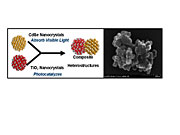- Number 302 |
- December 21, 2009
NETL Researchers Develop Promising New Photocatalyst for CO2 Reuse

(Left panel) Schematic diagram
of the new photocatalytic
technology for converting
CO2 into fuels. (Right panel)
SEM image of a heterostructured
CdSe/Pt/TiO2 photocatalyst
synthesized and tested by the
NETL team (scale bar 100 nm).
Researchers at the National Energy Technology Laboratory have developed a new, heterostructured photocatalyst capable of using the low-energy, visible-light portion of the electromagnetic spectrum for converting CO2 and H2O into methane, methanol, and other value-added chemicals. In this system, CdSe nanocrystals absorb visible light photons, creating excited electrons which are injected into TiO2 to reduce CO2. The photoactivity of this system can be systematically tuned to utilize different regions of the electromagnetic spectrum just by changing the size of the CdSe nanocrystal photosensitizer. This catalyst is believed to be the first developed that is capable of using the low-energy, visible-light portion of the electromagnetic spectrum for this process, and it represents a significant advance in the development of new technologies for CO2 capture and reuse. A manuscript detailing this new photocatalyst has been published in the Journal of Physical Chemistry Letters, and a provisional patent has also been filed on the technology.
[]
